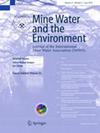海水中产生的水滑石用于修复酸性金属矿井排水和海底安置的评估
IF 2.1
4区 环境科学与生态学
Q3 WATER RESOURCES
引用次数: 0
Abstract
Abstract Uncontrolled release of acid mine drainage (AMD) causes widespread detrimental impacts on the receiving environment. Thus, effective treatment to neutralise AMD effluent pH and capture a suite of metals is required. In-situ hydrotalcite (HTC) precipitation is an emerging technology for AMD remediation. HTC has an inherent capacity to accommodate a range of cations and anions during in situ formation, offering a method of broad-spectrum contaminant removal. This study explored the feasibility of using seawater as an Mg source and synthetic AMD in HTC formation. The HTC was formed from a stoichiometric combination of synthetic AMD and seawater. While three initial stoichiometric M 2+ :M 3+ ratios of 2:1, 3:1, and 4:1 were investigated, only HTC with an M 2+ :M 3+ ratio of 2:1 was generated, as confirmed by both mineralogical and geochemical analyses. Importantly, the HTC was demonstrated to effectively remove a suite of metals present in AMD such as Cu, Zn, Al, and Mn with removal rates of between 99.97 to 99.99%. The HTC precipitate contained ≈6.6% Cu and 4.1% Zn, and thus shows the potential, if required, for future metal recovery. Since submarine placement is often used in metal mining and processing operations proximal to the coast, the stability of the HTC precipitate in seawater was also investigated. Importantly, only 0.2% of the Cu and 1.1% of the Zn within the HTC were subsequently leaching in decreasing increments into seawater over 30 days with decreasing increments after the initial seven days. This indicates robust element retention and confirms the potential of HTC for AMD remediation with direct submarine placement.海水中产生的水滑石用于修复酸性金属矿井排水和海底安置的评估
酸性矿井水的无节制排放对接收环境造成了广泛的危害。因此,需要有效的处理来中和AMD废水的pH值并捕获一套金属。原位水滑石(HTC)沉淀法是一种新兴的AMD修复技术。HTC在原位形成过程中具有容纳一系列阳离子和阴离子的固有能力,提供了一种广谱污染物去除方法。本研究探讨了以海水为镁源,在HTC地层中合成AMD的可行性。HTC是由合成AMD和海水的化学计量组合形成的。虽然研究了三种初始化学计量m2 +: m3 +比例分别为2:1、3:1和4:1,但矿物学和地球化学分析均证实,只生成了m2 +: m3 +比例为2:1的HTC。重要的是,HTC被证明可以有效地去除AMD中存在的一系列金属,如Cu, Zn, Al和Mn,去除率在99.97到99.99%之间。HTC沉淀物含有≈6.6%的Cu和4.1%的Zn,因此,如果需要的话,它显示出未来金属回收的潜力。由于潜艇经常用于靠近海岸的金属采矿和加工作业,因此还研究了海水中HTC沉淀物的稳定性。重要的是,在30天内,HTC中只有0.2%的Cu和1.1%的Zn浸出到海水中,浸出量逐渐减少,在最初的7天之后,浸出量逐渐减少。这表明了强大的元素保留,并证实了HTC通过直接潜艇安置进行AMD修复的潜力。
本文章由计算机程序翻译,如有差异,请以英文原文为准。
求助全文
约1分钟内获得全文
求助全文
来源期刊

Mine Water and the Environment
WATER RESOURCES-
CiteScore
5.00
自引率
14.30%
发文量
62
审稿时长
3 months
期刊介绍:
Mine Water and the Environment welcomes original contributions that address either technical questions or practical issues related to the evaluation, prediction, prevention, or control of water problems at mining operations or their impact on the environment. The journal and its audience is interdisciplinary. Manuscripts should convey new technical information and be of potential interest to researchers and/or practitioners in this field. Laboratory and field experiments, modelling efforts, studies of relevant field sites, technical evaluations of new technology, and engineering applications are all appropriate.
 求助内容:
求助内容: 应助结果提醒方式:
应助结果提醒方式:


